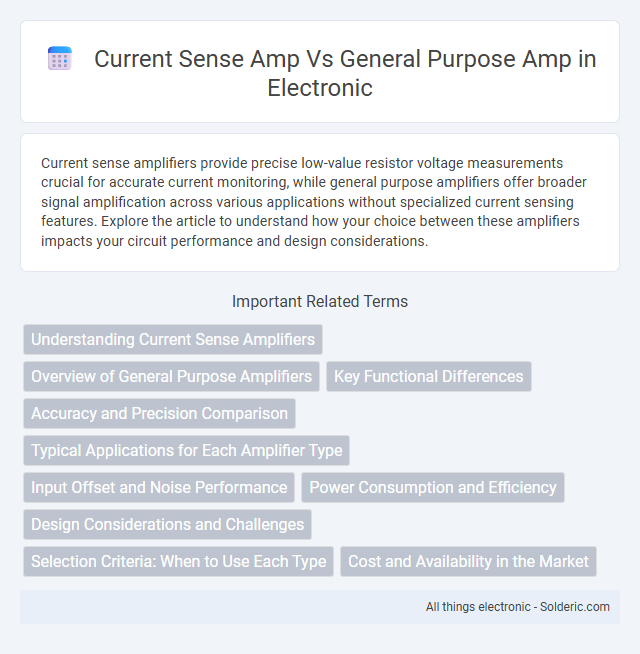Current sense amplifiers provide precise low-value resistor voltage measurements crucial for accurate current monitoring, while general purpose amplifiers offer broader signal amplification across various applications without specialized current sensing features. Explore the article to understand how your choice between these amplifiers impacts your circuit performance and design considerations.
Comparison Table
| Feature | Current Sense Amplifier | General Purpose Amplifier |
|---|---|---|
| Primary Function | Measures very low voltage across a sense resistor to detect current flow | Amplifies general analog signals without specific focus on current measurement |
| Input Type | Low-level differential voltage from shunt resistor | Varies widely, including single-ended and differential inputs |
| Sensitivity | High sensitivity to millivolt-level signals | Moderate sensitivity dependent on application |
| Common-Mode Voltage Range | Wide common-mode range, often including ground and supply voltages | Limited common-mode range, depends on amplifier design |
| Noise Performance | Optimized for low noise to enhance signal integrity at low levels | General noise performance based on type and model |
| Application | Current sensing in power management, battery monitoring, and motor control | Audio, instrumentation, signal conditioning, and general amplification tasks |
| Output | Accurate, amplified voltage proportional to sensed current | Amplified analog signal representing input voltage |
Understanding Current Sense Amplifiers
Current sense amplifiers specialize in accurately measuring low-side or high-side current by amplifying voltage drops across shunt resistors with high precision and low offset voltage. General purpose amplifiers lack the tailored input stages and common-mode voltage handling necessary for reliable current sensing in power management applications. Understanding current sense amplifiers enables you to select components optimized for real-time current monitoring, enhancing system efficiency and protection.
Overview of General Purpose Amplifiers
General purpose amplifiers are versatile electronic devices designed to amplify a wide range of input signals across various frequencies, making them suitable for everyday applications such as audio amplification and signal conditioning. These amplifiers prioritize linearity and low distortion, ensuring high-fidelity output for general tasks rather than specialized functions. If your project demands flexible signal amplification without the need for precise current sensing, a general purpose amplifier is a practical choice.
Key Functional Differences
Current sense amplifiers are specifically designed to accurately measure small voltage drops across low-value resistors for precise current monitoring, featuring low offset voltage and high common-mode voltage range. General purpose amplifiers offer versatile signal amplification without optimized parameters for current sensing, often lacking the specialized input stage required for low-level current measurements. Your choice depends on whether you need high accuracy in current sensing or broad amplification capabilities across various applications.
Accuracy and Precision Comparison
Current sense amplifiers offer higher accuracy and precision in measuring low-side currents by minimizing offset voltage and input bias current, which enhances signal integrity. General purpose amplifiers typically exhibit greater offset errors and lower input impedance, making them less suitable for precise current measurements. You should choose current sense amps when accuracy and precision in current monitoring are critical for your application.
Typical Applications for Each Amplifier Type
Current sense amplifiers excel in applications requiring precise measurement of small differential currents, such as battery monitoring, motor control, and power management systems. General purpose amplifiers find typical use in signal conditioning, audio amplification, and sensor interface circuits where wide bandwidth and versatility are essential. Selecting between these amplifier types depends on the specific requirements for accuracy, noise performance, and application environment.
Input Offset and Noise Performance
Current sense amplifiers exhibit significantly lower input offset voltage, typically in the range of a few microvolts, compared to general purpose amplifiers that often have input offset voltages in the millivolt range, enhancing measurement accuracy in current sensing applications. Noise performance in current sense amplifiers is optimized with low input-referred noise density, frequently below 10 nV/Hz, whereas general purpose amplifiers tend to have higher noise levels, making them less suitable for precise low-level signal detection. The specialized architecture of current sense amps ensures reduced input offset drift over temperature and superior noise rejection, critical for stable and accurate current monitoring.
Power Consumption and Efficiency
Current sense amplifiers are specifically designed to measure small differential voltages with high accuracy and consume significantly less power compared to general purpose amplifiers, making them ideal for energy-sensitive applications. General purpose amplifiers typically have higher power consumption due to broader functionality and less optimized architectures for low-level signal detection. Your choice of amplifier impacts overall efficiency, especially in battery-powered devices where minimizing power consumption is crucial.
Design Considerations and Challenges
Current sense amplifiers are designed specifically for accurately detecting small voltage drops across low-value resistors and require careful layout to minimize offset and noise. General purpose amplifiers prioritize versatility and often face challenges in precision and input bias current when used for current sensing tasks. Your choice must balance these design considerations to ensure optimal performance in applications demanding accurate current measurement.
Selection Criteria: When to Use Each Type
Current sense amplifiers are ideal for precise current monitoring in low-voltage, high-accuracy applications such as battery management or motor control, where minimal offset voltage and fast response time are critical. General purpose amplifiers suit a wider range of signal conditioning tasks requiring voltage amplification with moderate bandwidth and gain stability, often used in audio, sensor interfaces, and instrumentation circuits. Selection depends on the need for current measurement accuracy, input offset voltage, bandwidth, and power supply constraints relevant to the specific application.
Cost and Availability in the Market
Current sense amplifiers typically cost more than general-purpose amplifiers due to their specialized design for precision current measurement in power management and motor control applications. General-purpose amplifiers are widely available and come at a lower price point, making them suitable for broad, non-critical signal amplification tasks. Market availability favors general-purpose amplifiers because of their diverse usage across industries, while current sense amplifiers are found primarily through specialty suppliers targeting niche applications.
Current sense amp vs General purpose amp Infographic

 solderic.com
solderic.com